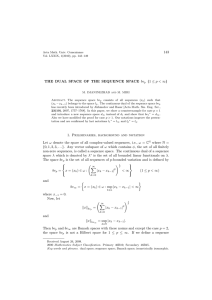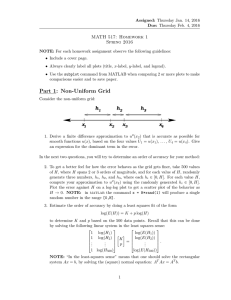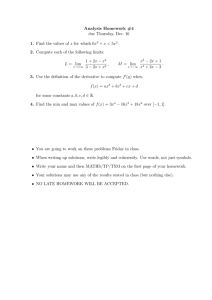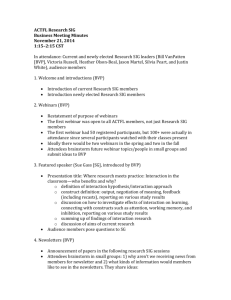THE DUAL SPACE OF THE SEQUENCE SPACE bv
advertisement
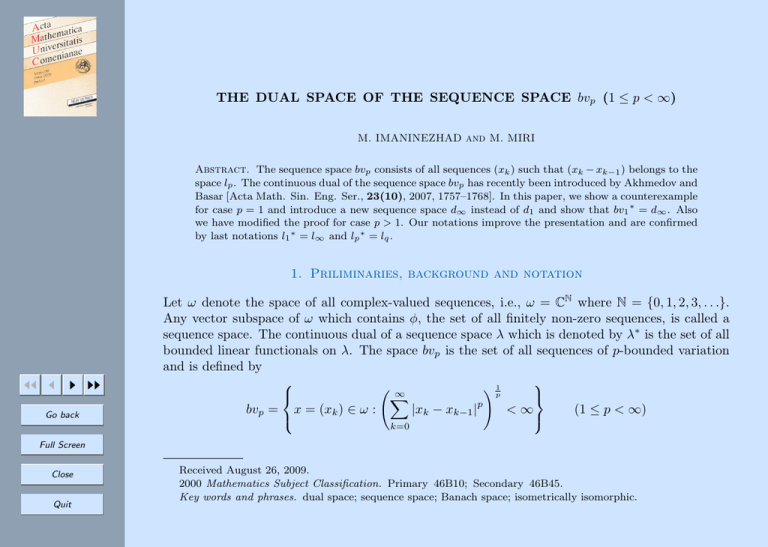
THE DUAL SPACE OF THE SEQUENCE SPACE bvp (1 ≤ p < ∞)
M. IMANINEZHAD and M. MIRI
Abstract. The sequence space bvp consists of all sequences (xk ) such that (xk − xk−1 ) belongs to the
space lp . The continuous dual of the sequence space bvp has recently been introduced by Akhmedov and
Basar [Acta Math. Sin. Eng. Ser., 23(10), 2007, 1757–1768]. In this paper, we show a counterexample
for case p = 1 and introduce a new sequence space d∞ instead of d1 and show that bv1 ∗ = d∞ . Also
we have modified the proof for case p > 1. Our notations improve the presentation and are confirmed
by last notations l1 ∗ = l∞ and lp ∗ = lq .
1. Priliminaries, background and notation
JJ J
I II
Go back
Let ω denote the space of all complex-valued sequences, i.e., ω = CN where N = {0, 1, 2, 3, . . .}.
Any vector subspace of ω which contains φ, the set of all finitely non-zero sequences, is called a
sequence space. The continuous dual of a sequence space λ which is denoted by λ∗ is the set of all
bounded linear functionals on λ. The space bvp is the set of all sequences of p-bounded variation
and is defined by
! p1
∞
X
p
bvp = x = (xk ) ∈ ω :
|xk − xk−1 |
<∞
(1 ≤ p < ∞)
k=0
Full Screen
Close
Quit
Received August 26, 2009.
2000 Mathematics Subject Classification. Primary 46B10; Secondary 46B45.
Key words and phrases. dual space; sequence space; Banach space; isometrically isomorphic.
and
bv∞ =
x = (xk ) ∈ ω : sup |xk − xk−1 | < ∞
k∈n
where x−1 = 0.
Now, let
kxkbvp =
∞
X
! p1
p
|xk − xk−1 |
k=0
and
kxkbv∞ = sup |xk − xk−1 |.
k∈N
JJ J
I II
Then bvp and bv∞ are Banach spaces with these norms and except the case p = 2, the space bvp
(k)
is not a Hilbert space for 1 ≤ p ≤ ∞. If we define a sequence b(k) = (bn )∞
n=0 of elements of the
space bvp for every fixed k ∈ N by
0, if n < k
(k)
bn =
1, if n ≥ k
∞
Go back
Full Screen
then the sequence (b(k) )k=0 is a Schauder basis for bvp and any x ∈ bvp has a unique representation
of the form
∞
X
x=
λk b(k)
Close
Quit
k=0
where λk = (xk − xk−1 ) for all k ∈ N.
2. A counterexample
In [1, Theorem 2.3] for case p = 1 suppose f = (3, −1, 0, 0, 0, . . .), i.e.,
f0 = f (e0 ) = 3,
f1 = f (e1 ) = −1,
Trivially f ∈ bv1∗ and
f (x) = f
∞
X
fk = f (ek ) = 0 for all k ≥ 2.
!
(∆x)k b(k)
= 2(∆x)0 − (∆x)1 .
k=0
So
kf k =
(1)
sup
kxkbv1 =1
|f (x)| = P
sup
∞
i=0
|2(∆x)0 − (∆x)1 | = 2.
|(∆x)i |=1
Now inequality (2.5) in [1, Theorem 2.3] asserts that kf k ≥ sup |
k,n∈N
Pn
j=k
fj | = 3 which is a
contradiction.
3. The Spaces d∞ and dq (1 < q < ∞)
JJ J
I II
Go back
In this section, we introduce two sequence spaces and show that they are Banach spaces and then
we give the main theorem of the paper. Let
∞ X ∞
d∞ = a = (ak )k=0 ∈ ω : kakd∞ = sup
aj < ∞
k∈N
Full Screen
and
Close
dq =
a=
(ak )∞
k=0
∈ ω : kakdq
X
q1
∞
∞ X
q
=
|
aj |
<∞ ,
k=0 j=k
Quit
j=k
(1 < q < ∞).
Theorem 3.1. d∞ is a sequence space with usual coordinatewise addition and scalar multiplication and k·kd∞ is a norm on d∞ .
Proof. We only show that k·kd∞ is a norm on d∞ . Let
1 1 1 1 1···
0 1 1 1 1···
D = 0 0 1 1 1··· .
0 0 0 1 1···
.. .. .. .. .. .. . .
.
......
Then
P∞
aj
1 1···
a0
Pj=0
∞
aj
1 1···
a1 Pj=1
∞
a2
1
1
·
·
·
aj
Da =
= Pj=2
.
∞
1 1···
j=3 aj
a3
.. .. . .
..
..
.. .
.
.
P∞
So kakd∞ = supk∈N j=k aj = supk∈N (Da)k = Dal . Now, if a ∈ d∞ then kDakl∞ =
∞
kakd∞ < ∞ hence Da ∈ l∞ . Also if Da ∈ l∞ , then kakd∞ = kDakl∞ < ∞ hence a ∈ d∞ . So
a ∈ d∞ if and only if Da ∈ l∞ . Now since
(I) 0 ≤ kDakl∞ = kakd∞ < ∞
(II) ka + bkd∞ = kDa + Dbkl∞ ≤ kDakl∞ + kDbkl∞ = kakd∞ + kbkd∞
(III) kα · akd∞ = kα · Dakl∞ = |α| · kDakl∞ = |α| · kakd∞
JJ J
I II
Go back
Full Screen
Close
Quit
k·kd∞ is a norm on d∞ .
111
011
001
000
.. .. .. ..
....
Theorem 3.2. d∞ is a Banach space.
Proof. Let (a(n) )∞
n=0 is a Cauchy sequence in d∞ . So for each ε > 0 there exists N ∈ N, such
that for all n, m ≥ N
ka(n) − a(m) kd∞ < ε.
So
kDa(n) − Da(m) kl∞ = ka(n) − a(m) kd∞ < ε.
(n)
→ a in l∞ .
So the sequence (Da(n) )∞
n=0 is Cauchy in l∞ . So there exists a ∈ l∞ such that Da
(n)
−1
(n)
−1
So kDa − DD akl∞ → 0 and ka − D akd∞ → 0
Furthermore, D−1 a ∈ d∞ since DD−1 a = a ∈ l∞ .
Theorem 3.3. bv1∗ is isometrically isomorphic to d∞ .
Proof. Define T : bv1∗ → d∞ and T f = (f (e(0) ), f (e(1) ), f (e(2) ), . . . ) where
e(k) = (0, . . . , 0, |{z}
1 , 0, . . .).
kth term
JJ J
I II
Go back
Full Screen
Close
Quit
Trivially, T is linear and injective since
T f = 0 ⇒ f = 0.
T is surjective since if g̃ = (g0 , g1 , g2 , g3 , . . .) ∈ d∞ then if we define f : bv1 → C by
f (x) =
∞
X
(∆x)k
k=0
∞
X
j=k
gj .
Then f ∈ bv1∗ . Trivially, since f is linear and
∞ ∞
∞
∞
X
X X
X
gj gj ≤
|(∆x)k | · |f (x)| = (∆x)k
k=0
≤
∞
X
k=0
j=k
j=k
k=0
X
∞
∞ X
|(∆x)k |.kg̃kd∞
gj =
|(∆x)k | sup
k∈N
k=0
j=k
= kg̃kd∞ .kxkbv1
and T f = g̃, so T is surjective. Now we show that T is norm preserving, we have
X
X
∞
∞
∞
X
X
∞
(j) (j) |f (x)| = f
(∆x)k
e
f (e )
= (∆x)k
k=0
≤
∞
X
k=0
j=k
k=0
j=k
∞
∞
∞
X
X
X
|(∆x)k |
f (e(j) ) ≤
|(∆x)k | · sup
f (e(j) )
k∈N
j=k
k=0
j=k
≤ kxkbv1 · kT f kd∞ .
So
JJ J
I II
Go back
Full Screen
Close
kf k ≤ kT f kd∞
(∗)
P∞
(k) P∞
(j) (j) (k)
On the other hand,
) ≤ kf k · kb kbv1 = kf k. So j=k f (e )≤ kf k for
j=k f (e ) = f (b
all k ∈ N.
So
∞
X
sup |
f (e(j) )| ≤ kf k,
k∈N
Quit
j=k
i.e.,
kT f kd∞ ≤ kf k
(†)
by (∗) and (†) we are done.
Theorem 3.4. dq (1 ≤ q < ∞) is a sequence space with usual coordinatewise addition and
scalar multiplication and k.kdq is a norm on dq .
Proof. With notations of Theorem 3.1 , kakdq = kDaklq and a ∈ dq ⇔ Da ∈ lq . The continuation of the proof is similar to Theorem 3.1.
Theorem 3.5. dq (1 ≤ q < ∞) is a Banach space.
Proof. The proof is similar to proof of Theorem 3.2 and we omit it.
JJ J
I II
Go back
Full Screen
Close
Quit
Theorem 3.6. Let 1 < p < ∞ and
1
p
+
1
q
= 1, then bvp∗ is isometrically isomorphic to dq .
Proof. Define A : bvp∗ → dq by f 7→ Af = (f (e(0) ), f (e(1) ), f (e(2) ), . . .). Trivially A is linear.
Additionally, since Af = 0 = (0, 0, 0, . . .) implies f = 0, A is injective. A is surjective since if
a = (ak ) ∈ dq and define f on the space bvp such that
f (x) =
∞
X
(∆x)k
k=0
∞
X
j=k
aj .
Then f is linear. Since
∞ ∞
X
X
|f (x)| ≤
aj (∆x)k
k=0
j=k
∞
X
(∆x)k p
≤
"
1
q
∞ X
X
∞ q
· aj = kxkbvp · kakdq ,
# p1
k=0
k=0 j=k
it yields to kf k ≤ kakdq < ∞. So f ∈ bvp∗ and Af = a.
Now, we show that A is norm preserving. Let f ∈ bvp∗ and x = (xk )∞
k=0 ∈ bvp , then
X
∞
∞
∞
X
X
∞
X
(∆x)k
|f (x)| = (∆x)k
f (e(j) ) ≤
f (e(j) )
k=0
j=k
∞
X
(∆x)k p
≤
"
k=0
JJ J
I II
Go back
Full Screen
Close
Quit
k=0
j=k
1
q q
∞ X
X
∞
· f (e(j) ) = kxkbvp · kAf kdq .
# p1
k=0 j=k
So
kf k ≤ kAf kdq .
(n) ∞
On the other hand, suppose f ∈ bvp∗ and x(n) = xk k=0 are such that
q−1
X
X
∞
∞
(j) (j)
f (e ) sgn
f (e ) , if (0 ≤ k ≤ n)
(∆x(n) )k =
j=k
j=k
0,
if k > n.
(∗)
P∞
We note that j=k f (e(j) ) = f (b(k) ). So x(n) ∈ bvp since ∆x(n) ∈ lp .
Then it is clear that
∆x(n) =
q−1 X
X
q−1 X
X
∞
∞
∞
∞
f (e(j) ) , 0, 0, . . . .
f (e(j) ) sgn
f (e(j) ) , . . . , f (e(j) ) sgn
j=n
j=0
j=0
j=n
So
∞
q−1 ∞
X
q−1 X
∞
X
X
∞
(j) (j)
(j) (j)
x(n) =
f
(e
)
sgn
f
(e
)
,
b
+
,
f
(e
)
sgn
f
(e
)
0
j=0
j=0
j=1
j=1
|
{z
}
{z
}
|
b0
b1
,...,
n
X
bk
k=0
JJ J
I II
Go back
Full Screen
Close
Quit
, t, t, t, . . .
.
| {z }
t=n+1th term
So if we let fk = f (e(k) ), then
f (x(n) ) = b0 f0 +
b0 f1 + b1 f1 +
b0 f2 + b1 f2 + b2 f2 +
b0 f3 + b1 f3 + b2 f3 + b3 f3 +
..
..
..
..
.
.
.
.
b0 fn + b1 fn + b2 fn + b3 fn + . . . + bn fn +
b0 fn+1 + b1 fn+1 + b2 fn+1 + b3 fn+1 + . . . + bn fn+1 +
b0 fn+2 + b1 fn+2 + b2 fn+2 + b3 fn+2 + . . . + bn fn+2 +
b0 fn+3 + b1 fn+3 + b2 fn+3 + b3 fn+3 + . . . + bn fn+3 +
..
..
..
..
..
..
.
.
.
.
.
.
n
∞
q
X X fj .
=
k=0 j=k
So
1
q p
n X
n X
∞
X
X
∞ q
fj = f (x(n) ) = |f (x(n) )| ≤ kf k · kx(n) kbvp = kf k ·
fj .
k=0 j=k
k=0 j=k
Since
"
kx
JJ J
(n)
kbvp = k∆x
(n)
klp =
I II
∞
X
# p1
(n)
|∆xk |p
Full Screen
p1
p
n X
∞
X
X
∞ q−1
fj sgn
fj
=
k=0
Close
Quit
=
n
X
k=0
k=0
Go back
"
=
j=k
j=k
p1
n X
X
∞ q
.
f
j
k=0 j=k
# p1
(n)
|∆xk |p
So
p1
1
n X
n
∞
X
X
X
∞ q
fj ≤ kf k ·
|
fj |q .
k=0 j=k
k=0 j=k
So
1
q
n X
X
∞ q
kf k ≥
fj = kAf kdq .
(†)
k=0 j=k
Therefore, by combinig the results (∗) and (†), A is norm preserving. Hence bvp∗ is isometrically
isomorphic to dq .
JJ J
I II
Acknowledgment. The authors would like to express their indebtedness to A. M. Akhmedov
and F. Basar since they were the source of inspiration. The first author thanks to several of
colleagues. Particularly, he is obliged to Dr. Bolbolian, Dr. Mohammadian and Dr. Roozbeh.
Also he would like to express his thanks to Mr. Davoodnezhad and Mrs. Sadeghi1 for supplying
him with some references.
Go back
Full Screen
Close
1. Akhmedov A. M. , Basar F., The Fine Spectra of the Difference Operator ∆ over the Sequence Space bvp (1 ≤
p < ∞) , Acta Math. Sin. Eng. Ser., 23(10) (2007), 1757–1768.
2. Basar F., Altay B., On the Space of Sequences of p-Bounded Variation and Related Matrix Mappings, Ukrainian
Math. J.,55(1) (2003), 136–147.
3. Goldberg S., Unbounded Linear Operators, Dover Publication Inc. New York, 1985.
1Librarians of Faculty of Mathematical Sciences of Mashhad University
Quit
4. Kreyszig E., Introductory Functional Analysis with Applications, John Wiley & Sons Inc. New York-ChichesterBrisbane-Toronto, 1978.
5. Wilansky A., Summability through Functional Analysis, North-Holland Mathematics Studies, Amsterdam-New
York-Oxford, 1984.
M. Imaninezhad, Islamic Azad University of Birjand, Iran,e-mail: imani507@gmail.com
M. Miri, Dep. of Math., University of Birjand,e-mail: mmiri@birjand.ac.ir
JJ J
I II
Go back
Full Screen
Close
Quit
